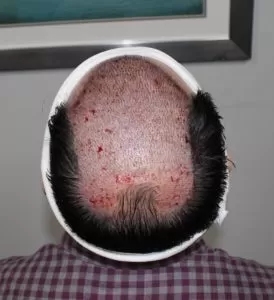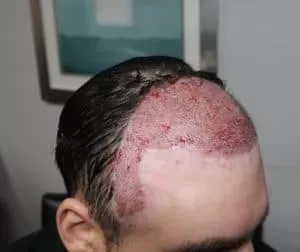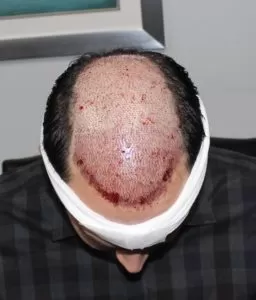“Doc, Why don’t we do 5,000 Grafts? Wouldn’t more Grafts Make a Better Hair Transplant Result?
One of the more common questions we are asked during consultations is: “Can we do more?”
It’s an understandable request; undergoing a hair transplant is a big deal for patients, and most want to do as much as possible in one sitting to obtain the best results and avoid undergoing future surgeries — if possible. So why not just do massive procedure of, let’s say, 5,000 grafts on all patients? Wouldn’t more grafts look better? Couldn’t we put them closer together and create more density if we used 5,000 or 6,000 grafts opposed to what was recommended? Well not necessarily, and, as it often is in medicine and surgery, it’s not that simple.
It’s About What you Need, not Necessarily What you Want

Immediately after a 4,102 graft procedure with Dr. Bloxham. Surgery performed within the last 2 weeks at Feller & Bloxham.
The reality is that most patients do not need 5,000 to 6,000 grafts in one sitting. For some perspective, it takes around 5,000 – 6,000 grafts to cover an entirely bald scalp “front to back” with adequate density. Most patients see us before they reach this level of hair loss. Most have thinning isolated to certain areas of the scalp, and this is all we need to address. This is one of the reasons why we more commonly recommend numbers closer to 2,500 grafts or 3,000 grafts in one sitting. If it takes 5,000 grafts to do a full scalp, it stands to reason that you may only need 2,500 or 3,000 to address the thinning in the frontal scalp — for example. While you may want to do 5,000 grafts in that area, it’s not necessary. It would be inappropriate — for reasons we will discuss shortly — to put this many grafts into an area only requiring half the number, just as it would be very wrong and inappropriate to take this many grafts and then not use them. Remember, you only have a limited number of grafts available in the donor area. Once they are gone, they are gone. You may very well want to use these extra grafts down the road. So only use what you need now and keep the others in reserve in the donor area for what you may want later.
What can we Safely Remove in One Sitting?
But what if you are thinning completely from front to back? What if you do need 5,000 to 6,000 grafts to address your hair loss? Can we do 5,000 then? Well, it depends. If we can safely take that many in one sitting, then absolutely. But that is a big “if.” First, most clinics are not equipped to perform a surgery of this size. A surgery this big should only be performed via the FUT (Follicular Unit Transplantation or “strip”) technique, and must only be attempted by a clinic comfortable with strip surgeries of this size. You must have experience with strip harvesting and master technicians comfortable dissecting and placing this many grafts. Attempting a surgery of this size when it is outside of the clinic’s comfort zone may be disastrous. Grafts may sit out for too long and perish; there may not be enough technicians to properly dissect the place the grafts; and the overall fatigue from attempting a procedure without adequate experience and resources may be too overwhelming for staff or the patient and the surgery may need to be stopped prematurely. I have seen all of these issues from clinics who “bit off more than they could chew” with massive mega sessions or “giga sessions.” I have also seen the awful consequences of attempting FUE sessions of this size. You are all but guaranteed to destroy the donor area and limit your options for styling (extreme thinness and patchiness in the donor) and surgery in the future.

Immediately after 3,500 graft FUT with Dr. Bloxham. Surgery performed within the last two weeks at Feller & Bloxham.
But it is not just about whether the clinic is equipped to handle a case of this size; it also depends on the patient. The truth is that most patients do not have the donor characteristics to safely give 5,000+ grafts in one sitting. Most patients are restricted by either the laxity (movement or “stretch”) of the scalp or their donor density. Unfortunately, some clinics do not let this stop them from shooting for 5,000+ grafts. They will simply take a larger strip than is safe, and hope it heals up okay. Often times, unfortunately, it does not. When the “stars align” and we see a patient with a broad donor area, excellent laxity, and excellent density, we can take a safe, reasonably sized strip and hit those very high graft numbers. Most of the time, however, a strip of this size will yield closer to 2,500 – 3,000 grafts. And this is okay. 2,500 and over is a mega session and should provide an excellent transformation. However, patients who need 5,000 – 6,000 grafts to fill the entire scalp but can only supply 2,500 – 3,000 in one sitting will simply need to undergo two procedures for full coverage. This is no problem and it is also how the vast majority of patients obtain full coverage. It is the exception and not the norm when a patient can do the 5,000 – 6,000 in one sitting. After the first strip harvest, the donor heals, the laxity returns, and the patient can return 12 months or so later for the second. You will still only have one incision line scar in the donor (because we remove the old scar with each subsequent strip), and you will still get the excellent full coverage.
Can’t you Take More to “Pack” them in “Tighter?”
Sometimes patients only need a set number of grafts to treat an area, but request that we remove and implant double the number in order to “double”

Immediately after a 4,000 graft FUT. Performed within the last two weeks by Dr. Bloxham at Feller & Bloxham Medical.
the density of the final result. For example, a patient may only need 2,000 for a frontal band restoration, but will request 4,000 to achieve tremendous density in the area. Do we honor this request? No, absolutely not. And not just to be mean, but because there are serious and detrimental consequences to purposely putting excessive grafts into an area. We at Feller & Bloxham are known for our “dense pack” approach. So we are not one to shy away from putting the grafts close together and achieving a dense restoration. However, you can only place them so close. It’s not a linear relationship where the more you put in, the better it will always look. Eventually you reach a tipping point where creating more incisions in a certain area irreversibly damages the tissue. Too many incisions means too much trauma to nerves and blood supply. When the blood supply is damaged that badly, the skin in that part of the scalp is “cut off” from all nourishment and two things happen: 1) the grafts will receive no blood supply and will not grow; 2) the skin will experience “necrosis” or skin death; the area will die, turn black, fall off, and leave a wound which may require additional treatment and a bad scar which will likely require future grafting — and there is no guarantee the scarred area will accept the grafts. The key is to take the density right to the “sweet spot” where we have packed quite a few grafts in there, but not too many where we are risking consequences. This sets the patient up for the thickest results with the best chance of everything growing without any negative effects. So, you do not need more grafts than what is recommended. As long as an adequate density is achieved, more is not more.
Curious about how many grafts you may need or may be able to do in one sitting? Feel free to come discuss your case with Hair Transplant specialist New York City. You may be a good candidate for an FUT mega-session. You may even be one of the lucky ones who needs and can achieve 5,000+ grafts in one sitting.
Feller & Bloxham Medical, PC





